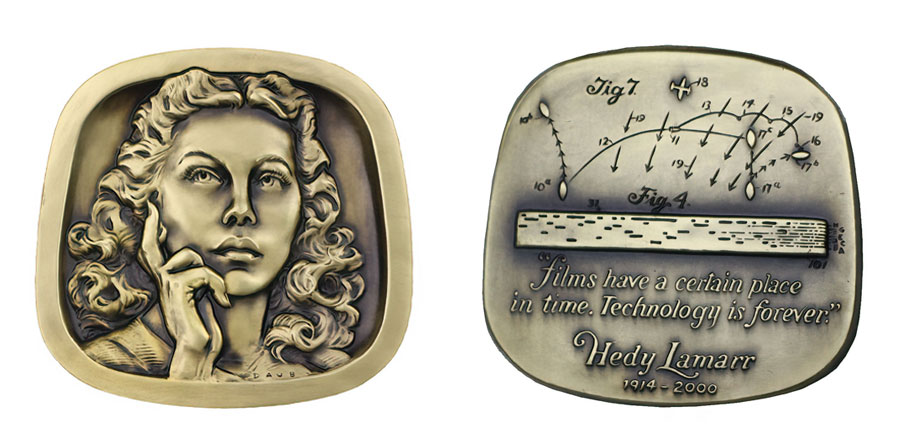Hedy Lamarr

This is an amazing portrait by Eugene Daub that belongs in the cabinet of every serious collector of coins and medals. Sculpting a full face front is difficult. Sculpting hands in proper proportion with anatomical correctness is difficult. Sculpting Eyes that are lifelike is challenging. Daub does all three on the portrait of Hedy Lamarr for this medal. The face is perfect in every way and the eyes reveal a layer of expression and personality that is unparalleled. The hands, well, compare hands on any other coin and medal and you will not see anything that comes close to being this good. Beyond just appreciating the sheer beauty, accuracy, and expression of the portrait, the Hedy Lamarr medal for the Jewish American Hall of Fame is a masterpiece and worthy of study by every artist who designs and sculpts coins and medals.
Hedy Lamarr (neé Hedwig Eva Maria Kiesler) was born to Jewish parents in 1914 in Vienna. In early 1933, at age 18, she starred in the movie Ecstasy, where she gained worldwide fame for a brief nude scene.
After she met Louis B. Mayer in Paris, he persuaded her to change her name to Hedy Lamarr and brought her to Hollywood. Lamarr made her American film debut in Algiers (1938), opposite Charles Boyer. According to one viewer, when her face first appeared on the screen, "everyone gasped—Lamarr's beauty literally took one's breath away." Hedy made 18 films from 1940 to 1949. After leaving MGM in 1945, she enjoyed her biggest success as Delilah in Cecil B. DeMille's Samson and Delilah, the highest-grossing film of 1949. Hedy Lamarr has a star on the Hollywood Walk of Fame at 6247 Hollywood Boulevard, adjacent to Vine Street.
During World War II, Lamarr learned that radio-controlled torpedoes could easily be jammed, thereby causing the torpedo to go off course. With the knowledge she had gained about torpedoes from her first husband, she thought of creating a frequency-hopping signal that could not be tracked or jammed. She contacted her friend, composer, and pianist George Antheil, to help her develop a device for doing that, and he succeeded by synchronizing a miniaturized player-piano mechanism with radio signals. They drafted designs for the frequency-hopping system, which they patented. However, it was technologically difficult to implement, and at that time the U.S. Navy was not receptive to considering inventions coming from outside the military—especially from a movie star.
Rather, Lamarr used her celebrity status to sell war bonds. Under an arrangement in which she would kiss anyone who purchased $25,000 worth of bonds, she sold $7 million worth in one night.
It wasn’t until the 1950s that engineers began experimenting with ideas documented in Lamarr and Antheil’s system. Their work with spread spectrum technology contributed to the development of GPS, Bluetooth, and Wi-Fi. So, whenever anyone uses their cell-phone or GPS he or she should think of Hedy.
Copyright Eugene Daub 2019 Contact / About Eugene